The
Continental Congress recommended Georgia and the Carolinas launch an
expedition into British East Florida. The objective was to retaliate against the cattle raids on coastal Georgia plantations
by Loyalist Florida Rangers and Creek Indians, and drive them further
south of the St. Marys River. In addition, they wanted to defeat the
garrison of 500 British Regulars of the 60th Royal American
Regiment
stationed
at St. Augustine, British East Florida, who were planning to invade
Georgia and capture Savannah.
was to retaliate against the cattle raids on coastal Georgia plantations
by Loyalist Florida Rangers and Creek Indians, and drive them further
south of the St. Marys River. In addition, they wanted to defeat the
garrison of 500 British Regulars of the 60th Royal American
Regiment
stationed
at St. Augustine, British East Florida, who were planning to invade
Georgia and capture Savannah.
First Florida Expedition - June – Sept. 1776
In
June, 1776, Major General Charles Lee, Southern Department Continental
Army Commander, decided to execute the first expedition into Florida.
Despite the fact that he had no heavy artillery to besiege Fort St. Mark (Castillo de San Marcos)
in
St. Augustine, Lee believed that his 1,500 men from Carolinas, Virginia
and Georgia Continental units could demolish the hundred Loyalist
plantations between the St. Marys and St. John’s Rivers, and intimidate
the Creek Indians to keep out of the fight. Also, the Georgia Council of
Safety assumed that if the Loyalists in East Florida were forced to take
refuge in St. Augustine, a lack of food would cause surrender by the
British.
Lee’s Continentals captured and burned the
Pagan Creek Plantation
fort of the brothers of Georgia Royal Governor James Wright, Charles &
Jermyn Wright, on the St. Marys River. But dissension plagued the
expedition, with arguments about precedence of commission and the Georgia
Council of Safety proposing missions far beyond their resources.
Unfortunately in August, Lee was recalled to the North, taking his
Virginia and North Carolina troops with him.
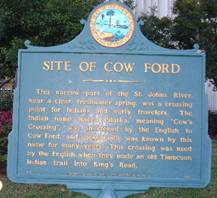 The
main expedition got no farther than Sunbury, when the South Carolina
Continentals were ordered to return to Charleston. As the 300 Georgia
Continental Army and Militia, under recently promoted Brigadier General
Lachlan McIntosh, moved in force towards Florida, disease, heat and
desertions increased.
The
main expedition got no farther than Sunbury, when the South Carolina
Continentals were ordered to return to Charleston. As the 300 Georgia
Continental Army and Militia, under recently promoted Brigadier General
Lachlan McIntosh, moved in force towards Florida, disease, heat and
desertions increased.
The
Georgians’ advance guard reached the St. Johns River and fought a band of
pro-British Indians at the Cow Ford, now Jacksonville. This narrow part of
the St. Johns River, near a clear freshwater spring was a crossing point
for Indians and early travelers. The
Cow Ford Historical Marker is
located on the grounds of the Duval County Courthouse in downtown
Jacksonville, Florida.
The
Georgians also skirmished with Florida Rangers and their Indian allies on
Satilla River; but never engaged the British Regulars and did not even
threaten St. Augustine.
Both sides built new fortifications during the summer of 1776. Georgia’s
Fort McIntosh, named for General McIntosh, was placed on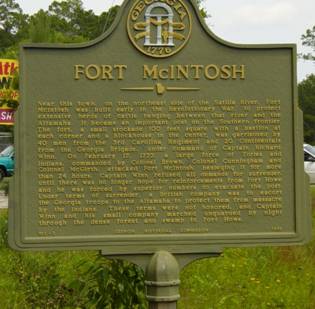 the banks of the Satilla River to protect
extensive herds of cattle ranging between that river and the Altamaha. The
fort, a small stockade 100 feet square with a bastion at each corner and a
blockhouse in the center, was garrisoned by 40 men to protect the
Georgia portion of the King’s Road. The
Fort McIntosh Historical Marker
is located at intersection of U.S. Hiway 82
& Ga. Hiway 110 in Atkinson, Brantley County, Georgia.
the banks of the Satilla River to protect
extensive herds of cattle ranging between that river and the Altamaha. The
fort, a small stockade 100 feet square with a bastion at each corner and a
blockhouse in the center, was garrisoned by 40 men to protect the
Georgia portion of the King’s Road. The
Fort McIntosh Historical Marker
is located at intersection of U.S. Hiway 82
& Ga. Hiway 110 in Atkinson, Brantley County, Georgia.
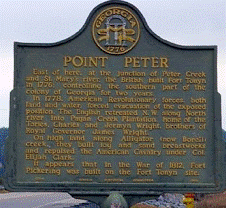 British
Fort Tonyn, named for British East Florida Governor Patrick Tonyn, was
constructed in present-day Nassau County, Florida, near the hamlet of
Mill's Ferry, about twenty-five miles upstream on the St. Marys River near
the King’s Road ferry crossing. The Florida Rangers, who were stationed
at Fort Tonyn, provided the front line of defense for British East
Florida, and also controlled the southern part of the colony of Georgia
for two years.
The
Fort Tonyn- Point Peter Historical
Marker
is located at Point Peter Rd. near intersection with Osborne in St. Marys,
Georgia
British
Fort Tonyn, named for British East Florida Governor Patrick Tonyn, was
constructed in present-day Nassau County, Florida, near the hamlet of
Mill's Ferry, about twenty-five miles upstream on the St. Marys River near
the King’s Road ferry crossing. The Florida Rangers, who were stationed
at Fort Tonyn, provided the front line of defense for British East
Florida, and also controlled the southern part of the colony of Georgia
for two years.
The
Fort Tonyn- Point Peter Historical
Marker
is located at Point Peter Rd. near intersection with Osborne in St. Marys,
Georgia
During the early 1760’s, the Kings Road was built by the British on an
old
Timucuan Indian Trail from St. Augustine to the
St. Marys River, and then connected with the Kings Road in Georgia.
This major north-south route 200
miles long and 16 feet wide, stretched all the way from Savannah to St.
Augustine. In the 19th Century, the road was called Post Road.
The
Kings Road – Old Post Road Historical
Marker is located Location:
Ga. Highway 32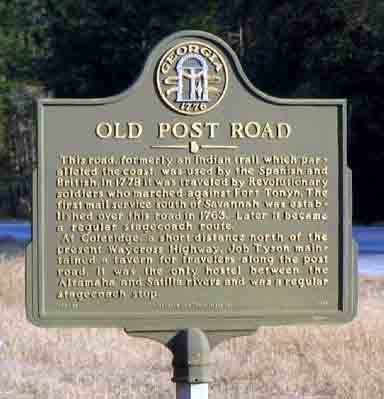 and Post Road at the Brantley and Glynn County border.
and Post Road at the Brantley and Glynn County border.
The
food shortage the Georgia Council of Safety had counted on to cripple St.
Augustine did develop. By early 1777, British East Florida Governor
Patrick Tonyn addressed the problem by planning a cattle raid well north
of the St. Marys River. In February 1777, Florida Rangers Lt.Col. Thomas
“Burnfoot” Brown encountered the Patriot’s new stockade post on the
northeast bank of the Satilla River. After fighting of about five hours,
Brown approached Fort McIntosh with a flag and demanded its surrender. The
following day, February 18, British Lt.Col. Valentine Fuser sent
Continental Captain Richard Winn a message telling him to come out and
examine the British preparation for the attack. After some negotiations,
Winn surrendered the fort.
After burning the fort the British returned to St. Augustine with nearly
2,000 head of cattle.
The
Georgia Council of Safety now realized the gravity of a British invasion,
and asked the Continental Army to support them again. Also, the Council
granted President Archibald Bulloch absolute executive powers to take
action for the expected British attacks, but Bulloch died mysteriously at
his home a few days later, only 47 years old.
Second Florida Expedition - April – June, 1777
Late in February 1777, the Georgia Council of Safety elected Button
Gwinnett to succeed Archibald Bulloch as its President and Commander of
the Georgia Militia. Gwinnett decided to capture St. Augustine
in retaliation for the raids by Florida Loyalist into Georgia,
and asked Continental Major General Robert Howe, Lee’s successor as
commander of the Southern Department, for Continental troops.
Howe was reluctant to commit his limited resources to launch another
invasion of East Florida. Although he did order the 600 man Georgia
Continental battalion, commanded by General Lachlan McIntosh, to proceed
to Sunbury, Howe took his 1,000 South Carolina Continentals to Charleston.
Gwinnett proceeded aggressively with his plan without consulting McIntosh,
but the Militia failed to muster a sufficient number of volunteers — fewer
than 200 men, and Gwinnett had to request McIntosh’s aid.
As
divided Georgians prepared for their invasion of East Florida, the British
acknowledged their need for a general officer in Florida. Colonel
Augustine Prevost was appointed Major General and given control over all
Florida British forces- the Regulars, Rangers and Indians.
Heading south from Savannah, General McIntosh and Button Gwinnett,
repeatedly fought over command, so much so that when the expedition
reached Sunbury there were orders waiting for both men to return to
Savannah. The Georgia Council of Safety placed Colonel Samuel Elbert in
charge of the expedition. Elbert’s brigade was poorly equipped; the
soldiers were furnished raw deerskins with which to make their own
moccasins, and some of the riflemen carried only spikes.
With a planned rendezvous on May 12 at Sawpit Bluff near the mouth of the
Nassau River (twelve miles north of the mouth of the St. Johns River),
Colonel Elbert divided his forces at Sunbury. On April 27, he ordered
Lieutenant Colonel John Baker
to
proceed overland to join Colonel Thomas Sumter’s South Carolina Militia at
Fort Howe on the Altamaha, and then proceed to the appointed
rendezvous
on the Nassau River.
Baker’s forces included 150 to 180 horsemen; composed of
109
volunteers from the Georgia Militia and those of his Georgia Continental
Light Horse Regiment who possessed mounts.
Elbert then embarked 400 Continentals, from First and Second Georgia
Battalions, on vessels commanded by Commodore Oliver Bowen including:
three galleys, two armed sloops, and some transports carrying twenty
cannon to travel through Inland Passage to Sawpit Bluff near the south end
of Amelia Island. This water route offered protection from unpredictable
weather and harsh conditions of the open sea.
At
Fort Howe, Baker learned that General Howe had ordered Sumter and his
South Carolinians back to Charleston. The rivers were so swollen by spring
rains that Baker spent two days crossing the Altamaha. Indians attacked
his camp, and
two
Georgians, Lieutenants Robeson and Frazer, were wounded and one Indian was
killed. They faced additional delays when crossing the swollen Satilla and
St. Marys rivers.
Baker finally crossed the St. Marys River on May 10, and two
days later they
arrived at the rendezvous point,
Sawpit Bluff, at the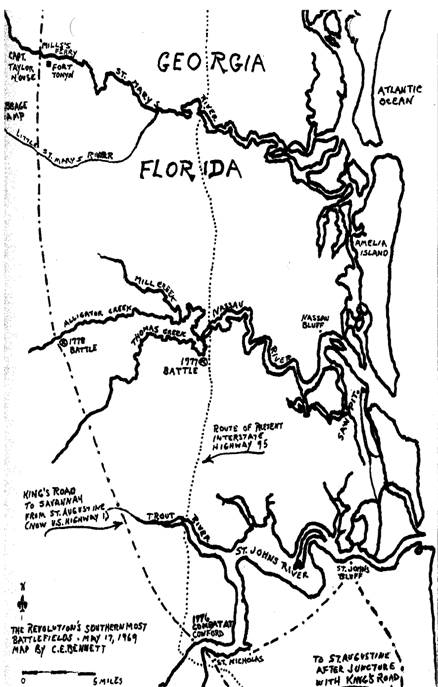 appointed time. Baker
found that Elbert had not arrived,
and learned that
Elbert’s flotilla was still north of the St. Marys River.
Baker
erected a fortified camp at
Sawpit Bluff,
and ordered forty mounted men commanded by his brother, Major William
Baker, to conduct reconnaissance patrols as far south as the Cow Ford.
During the next three days, they learned that the British knew of their
approach and were planning to challenge their advance.
appointed time. Baker
found that Elbert had not arrived,
and learned that
Elbert’s flotilla was still north of the St. Marys River.
Baker
erected a fortified camp at
Sawpit Bluff,
and ordered forty mounted men commanded by his brother, Major William
Baker, to conduct reconnaissance patrols as far south as the Cow Ford.
During the next three days, they learned that the British knew of their
approach and were planning to challenge their advance.
On May
14, British Loyalist
Lieutenant Colonel
Brown embarked about forty Rangers and
Indians aboard a schooner and sailed from the Cow Ford up the St. Johns
River to Trout Creek, where they began searching for Baker and his men.
Within three hours, they found the Georgians camped nine miles away.
Before Brown could attack, his men were seen by a sentinel and retreated
to his ship on Trout Creek to notify Major Marc Prevost, now commander of
the British Regulars. Brown ordered fifteen Indians, led by a warrior
named Black Creek Factor, to steal some of the Georgians' 250 horses.
The next
morning, the Indians and forty horses were found by Baker’s detachment; a
brief skirmish ensued where two Georgians were wounded, and one Creek was
killed. The Georgians scalped their Indian victim, an act which drove the
Indians into uncontrollable rage. The Georgians were to regret this action
in the aftermath of the Battle of Thomas Creek. Brown then returned to the
Cow Ford to rejoin the British Regulars.
Not
finding Elbert at the Nassau River, but knowing that the British were
aware of the size and location of his command, Baker
decided not to wait any longer for Elbert’s Continentals. He moved to a
place on Thomas Creek he felt was more favorable from which to retreat if
attacked by a superior force.
Meanwhile, Major Marc Prevost, commander of the 60th Royal
American Regiment, crossed the St. Johns River with 100 British Regulars,
100 Loyalist Florida Rangers and a few Indians. They marched northward to
Frederick Rolfe’s Saw Mill on Trout Creek (eleven miles north of
Jacksonville), and encamped on May 16th to await news of
Baker’s location. During the night, one of the Rangers located Baker’s
force east of King’s Road on the south bank of Thomas Creek, and reported
the news to Prevost.
At about 10 o’clock in the morning of the May 17, the British force
surprised Baker’s men. The plan was for Brown to engage Baker’s men while
Prevost advanced from the rear. Brown positioned some Rangers on Baker’s
flank, while his main body fired at
Baker’s oncoming mounted troops at a range of 50 yards. Baker had no
alternative but to retreat directly into Prevost’s Regulars who were
advancing rapidly in three columns with fixed bayonets.
A large number of Baker’s men,
surrounded by Regulars, Rangers and Indians,
simply deserted or fled at first fire.
In the ensuing action, the remaining Georgians responded,
but were quickly overwhelmed and retreated into the swamp.
Baker’s casualties included a number killed, including Lieutenants John
Frazer and McGowen; nine wounded, including Lieutenant James Robeson, many
of whom died in the nearby woods;
thirty-one surrendered or captured, included
Lieutenant
Ignatius Few and Captain William Williams. In revenge for the mutilation
of the Indian earlier, the Creek Indians killed and scalped two dozen of
the prisoners. According to Major Marc Prevost, the remaining prisoners
were saved with great difficulty. Colonel Elbert wrote a letter to Prevost
protesting the treatment of the prisoners, concluding with “if Savages
can’t be restrained, why are they Employed?”
Colonel Elbert had arrived on the north end of Amelia Island on May 18,
and dispatched
Lieutenant
Robert Ward with about twenty men to the south end of the island to round
up the inhabitants and prevent them from relaying Elbert’s position to
Loyalists on the mainland. An additional group was sent to obtain cattle
and other provisions. Some Loyalists fired on Ward’s party, killing him
and seriously wounding two others. In retaliation, Elbert ordered
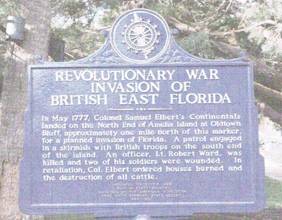 Leutenant
Jacob Winfree to burn every house on Amelia and destroy all the stock. For
six days, the Georgia galleys tried to get through the Amelia Narrows into
the Nassau River, but with too much draft and too much weight including
the eleven cannons on board, they could not.
Elbert’s Amelia Island
Historical Marker is Located at the Railroad
Depot Plaza in Fernandina Beach
Leutenant
Jacob Winfree to burn every house on Amelia and destroy all the stock. For
six days, the Georgia galleys tried to get through the Amelia Narrows into
the Nassau River, but with too much draft and too much weight including
the eleven cannons on board, they could not.
Elbert’s Amelia Island
Historical Marker is Located at the Railroad
Depot Plaza in Fernandina Beach
The
British found a complete set of plans in Baker’s camp for the invasion
of Florida, but it didn't matter since Elbert and his men could not
navigate the Amelia Narrows, had been stricken by disease on the boats,
and had decided to wait for Baker at Amelia Island. Only Baker and
eighteen of his men
escaped to join Elbert.
On
May 26, Elbert decided to return to Georgia and reached Cumberland Island
with 300 men, including Baker’s horsemen. His troops
reached the Satilla River on June 1; where he left wounded and then
marched to Fort Howe. Elbert ordered the galleys to transport the troops
remaining on the Satilla back to Savannah, where all returned by June 15.
The
second invasion of East Florida ended with the loss of about 250 men, many
from disease contracted in the heat and swampy conditions, and no success
in preventing the Florida Rangers and Indians from continuing to raid
coastal Georgia plantations. Samuel Elbert urged that all cattle be driven
north of the Altamaha River. He said that the cattle between the Altamaha
and the St. Mary’s Rivers were a “Magazine (storage) for our Enemies.”
Historical
Marker--Battle Of Thomas Creek

When the American War of Independence began, the new British colonies of
East and West Florida did not seek separation from England. East Florida
remained comparatively free from serious fighting throughout the course of
the Revolutionary War. In the summer of 1777, however, Americans initiated
an invasion aimed at capturing St. Augustine. The expedition was composed
of Continental Army troops and Georgia militia forces under the command of
Lt. Col. Samuel Elbert. Preparations for the defense of east Florida
involved the East Florida Rangers, a force of mounted provincials, British
Regulars, and Indian allies. On May 17, 1777, a portion of the invading
American expedition was attacked by a detachment of British Regulars under
Maj. J.M. Prevost assisted by Rangers under Col. Thomas Brown and Indians.
The battle took place at a site on Thomas Creek south of its confluence
with the Nassau River. After suffering heavy casualties, the Americans,
already discouraged by lack of supplies and the heat, began their retreat
from Florida. Only one more unsuccessful invasion of East Florida occurred
during the remaining years of the American Revolution. Florida
Society, Children of the American Revolution in Cooperation with
Department of State, 1975
The Thomas Creek Historical Marker is located on U.S. Highway 1
where it crosses Thomas Creek, about four miles south
of Callahan on the border of Nassau and Duval Counties.
Although not specifically located, the site Battle of Thomas Creek is
believed to have occurred in what is now a part of the Timucuan Ecological
and Historic Preserve, National Park Service. It is approximately thirteen
miles north of downtown Jacksonville.
Duel of Button Gwinnett and Lachlan McIntosh – May 16, 1777
Contention for civil and military dominance existed between the Georgia
Whig factions- “Radical” and “Conservative.” Button Gwinnett, Dr. George
Wells, John Adam Treutlen, Dr. Lyman Hall, Edward Langworthy and Joseph
Wood led the Radicals. They were based not only in St. John Parish –
Midway and Sunbury--on the coast, but also in the Backcountry --the Ceded
Lands, St. George Parish, and St. Paul Parish, including Augusta. John
Wereat, Joseph Clay, Joseph Habersham, George Walton, Samuel Elbert, and
Lachlan McIntosh led the Conservatives, located primarily in Savannah. The
Radicals were the dominant political faction during most of the American
Revolution and directed more of their fury against the Conservatives than
their common enemy, the British.
Button Gwinnet's arrest of George McIntosh, the brother of General Lachlan
McIntosh, for suspected treason fueled the animosity between Radical and
Conservative Georgians. At the height of the controversy, Gwinnett decided
upon an invasion of Florida. As President and commander of the Georgia
Militia, Gwinnett refused to cooperate with McIntosh, who commanded the
Continental soldiers. Disputes over command of the expedition caused the
Georgia Council of Safety to recall both Gwinnett and McIntosh to
Savannah.
This struggle led to a duel between Lachlan McIntosh and Button Gwinnett
on May 16, 1777, (one day prior to the Battle of Thomas Creek.) Both men
fired low and both were wounded; McIntosh recovered, but Gwinnett died
several days later. The Radical Whigs raised such a cry against McIntosh
that Congress transferred him out of Georgia for service under General
George Washington at Valley Forge, Pennsylvania.
Prepared by Bill Ramsaur, Marshes of Glynn Chapter, Georgia Society Sons
of the American Revolution, Revised 2/15/2014
References:
-
Boatner, Mark M. Landmarks of the American Revolution.
(Harrisburg,
PA: Stackpole Books, 1973)
-
Buker, George E. and Richard A.
Martin. “Governor Tonyn’s Brown-Water Navy: East Florida During The
American Revolution, 1775-1778,” The Florida Historical Quarterly,
Volume 58, Issue 1, (July 1979), pp 58-71.
-
Cashin, Edward J (1999). The King's Ranger: Thomas Brown and the
American Revolution on the Southern Frontier (Bronx, New York:
Fordham University Press, 1999)
-
Searcy, Mary. The Georgia–Florida Contest in the American Revolution,
1776–1778 (University, AL: University of Alabama Press, 1985)
-
Smith, Gordon Burns. Morningstar’s
of Liberty: The Revolutionary War in Georgia 1775-1783, Volume One
(Milledgeville: Boyd Publishing, 2006)
-
Smith, Gordon Burns. Morningstar’s
of Liberty: The Revolutionary War in Georgia 1775-1783, Volume Two-
Georgia Continental Officers During the Revolutionary War
(Milledgeville:
Boyd Publishing, 2011)
-
Wood, Virginia Steele. “The Georgia Navy’s Dramatic Victory of April 19,
1778” Georgia Historical Society Quarterly 90, no 2 (2006) pp
165-195